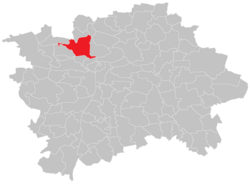Dejvice | |
|---|---|
Cadastral Area of Prague | |
 Building of the General Staff of the Czech Army | |
 Location of Dejvice in Prague | |
| Coordinates: 50°06′22″N14°22′13″E / 50.10611°N 14.37028°E | |
| Country | Czech Republic |
| Region | Prague |
| District | Prague 6 |
| Area | |
• Total | 7.39 km2 (2.85 sq mi) |
| Population (2021) [1] | |
• Total | 23,401 |
| • Density | 3,200/km2 (8,200/sq mi) |
| Time zone | UTC+1 (CET) |
| • Summer (DST) | UTC+2 (CEST) |
Dejvice is a historical community, a municipal quarter of the Prague 6 district of Prague, Czech Republic. Its history can be traced back to the late Roman era. Dejvice is known for its appeal to the upper middle class, foreign diplomatic corps and as a university district. It is also the home to Dukla Prague, one of the most successful football clubs of the Czechoslovak era.

